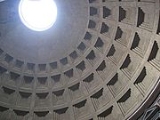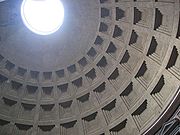
Coffer
Encyclopedia

Architecture
Architecture is both the process and product of planning, designing and construction. Architectural works, in the material form of buildings, are often perceived as cultural and political symbols and as works of art...
, is a sunken panel in the shape of a square, rectangle, or octagon in a ceiling
Ceiling
A ceiling is an overhead interior surface that covers the upper limit of a room. It is generally not a structural element, but a finished surface concealing the underside of the floor or roof structure above....
, soffit
Soffit
Soffit , in architecture, describes the underside of any construction element...
or vault
Vault (architecture)
A Vault is an architectural term for an arched form used to provide a space with a ceiling or roof. The parts of a vault exert lateral thrust that require a counter resistance. When vaults are built underground, the ground gives all the resistance required...
. A series of these sunken panels were used as decoration for a ceiling or a vault, also called caissons ('boxes"), or lacunaria ("spaces, openings"), so that a coffered ceiling can be called a lacunar ceiling: the strength of the structure is in the framework of the coffers. The stone coffers of the ancient Greeks and Romans
Ancient Rome
Ancient Rome was a thriving civilization that grew on the Italian Peninsula as early as the 8th century BC. Located along the Mediterranean Sea and centered on the city of Rome, it expanded to one of the largest empires in the ancient world....
are the earliest surviving examples, but a seventh-century BC Etruscan chamber tomb in the necropolis of San Giuliano, which is cut in soft tufa-like stone reproduces a ceiling with beams and cross-beams lying on them, with flat panels fillings the lacunae. Wooden coffers were first made by crossing the wooden beams of a ceiling in the Loire Valley
Loire Valley
The Loire Valley , spanning , is located in the middle stretch of the Loire River in central France. Its area comprises approximately . It is referred to as the Cradle of the French Language, and the Garden of France due to the abundance of vineyards, fruit orchards, and artichoke, asparagus, and...
château
Château
A château is a manor house or residence of the lord of the manor or a country house of nobility or gentry, with or without fortifications, originally—and still most frequently—in French-speaking regions...
x of the early Renaissance.
Experimentation with the possible shapes of the pole is coffering, which solve problems of mathematical tiling, or tessellation
Tessellation
A tessellation or tiling of the plane is a pattern of plane figures that fills the plane with no overlaps and no gaps. One may also speak of tessellations of parts of the plane or of other surfaces. Generalizations to higher dimensions are also possible. Tessellations frequently appeared in the art...
, were a feature of Islamic as well as Renaissance architecture
Renaissance architecture
Renaissance architecture is the architecture of the period between the early 15th and early 17th centuries in different regions of Europe, demonstrating a conscious revival and development of certain elements of ancient Greek and Roman thought and material culture. Stylistically, Renaissance...
. The more complicated problems of diminishing the scale of the individual coffers were presented by the requirements of curved surfaces of vaults and domes.
A prominent example of Roman coffering, employed to lighten the weight of the dome, can be found in the ceiling of the rotunda
Rotunda (architecture)
A rotunda is any building with a circular ground plan, sometimes covered by a dome. It can also refer to a round room within a building . The Pantheon in Rome is a famous rotunda. A Band Rotunda is a circular bandstand, usually with a dome...
dome
Dome
A dome is a structural element of architecture that resembles the hollow upper half of a sphere. Dome structures made of various materials have a long architectural lineage extending into prehistory....
in the Pantheon, Rome
Pantheon, Rome
The Pantheon ,Rarely Pantheum. This appears in Pliny's Natural History in describing this edifice: Agrippae Pantheum decoravit Diogenes Atheniensis; in columnis templi eius Caryatides probantur inter pauca operum, sicut in fastigio posita signa, sed propter altitudinem loci minus celebrata.from ,...
.
In ancient Chinese wooden architecture
Ancient Chinese wooden architecture
Ancient Chinese wooden architecture is among the least studied of any of the world's great architectural traditions from the western point of view. Although Chinese architectural history reaches far back in time, descriptions of Chinese architecture are often confined to the well known Forbidden...
, coffering is known as zaojing
Caisson (Asian architecture)
The Caisson , also referred to as a caisson ceiling, or spider web ceiling, in East Asian architecture is an architectural feature typically found in the ceiling of temples and palaces, usually at the centre and directly above the main throne, seat, or religious figure.The caisson is generally a...
.

See also
- DomeDomeA dome is a structural element of architecture that resembles the hollow upper half of a sphere. Dome structures made of various materials have a long architectural lineage extending into prehistory....
- Dropped ceilingDropped ceilingA dropped ceiling is a secondary ceiling, hung below the main ceiling. They may also be referred to as a drop ceiling, false ceiling, or suspended ceiling, and are a staple of modern construction and architecture. The area above the dropped ceiling is called the plenum space, as it is sometimes...
- Luminous ceiliing
- Cove ceiling
- BeamBeam (structure)A beam is a horizontal structural element that is capable of withstanding load primarily by resisting bending. The bending force induced into the material of the beam as a result of the external loads, own weight, span and external reactions to these loads is called a bending moment.- Overview...
ceiling

